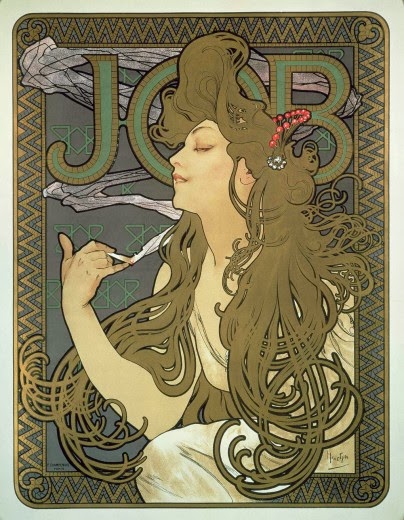Art Nouveau and Mucha Mythology
As many of you reading this may know, I am infatuated with art nouveau, a type of design inspired by natural elements with lots of heavy-handed curved lines. While its popularity spread globally, it can be most frequently seen in art and architectural structures throughout Europe, which is likely why I fall for practically every city I visit here.
A huge influence on the movement was Alphonse Mucha, an artist from the Czech Republic who spent much of his time in France. It is his commercial work that initially drew me to the style (one I hope to emulate some day in a half-sleeve tattoo [sorry mom]) and I was delighted to discover that during my weekend in Prague I would have the opportunity to visit a museum dedicated to his ingenuity.
Mucha is thought to have revolutionized poster design in the late 1800's with an advertisement he created for renowned actress Sarah Bernhardt when she was to play Gismonda at Theatre de la Renaissance in Paris. An overnight success, Mucha went on to design more ads for Bernhardt as well as other products such as cigarette papers and bicycles.
Following much success, Mucha returned to his home country to produce the Slav Epic, a gift to his homeland that spanned a half square kilometre of canvas and took eighteen years to create. He wished to perpetuate a strong national consciousness and contribute to the culture he felt had shaped him, and devoted the remainder of his career to this as well as his depictions of Slavic folklore.
One later piece that stood out to me is the above poster prepared for the first exhibition of the complete Slav Epic in which Mucha has taken a figure from the epic itself and added the mythological Svantovit, a Slavic deity of war and abundance. His three faces represent the past, present and future and his link with divination, and he is portrayed with his two emblems, the sword and drinking horn.
Mucha's work is rife with symbolism, making it the perfect subject for my ravings. Travelling to discover more instances of art nouveau and mythology, and to write about them is basically my notion of an ideal life.
"The aim of my work was never to destroy, but to build bridges" - Alphonse Mucha
A huge influence on the movement was Alphonse Mucha, an artist from the Czech Republic who spent much of his time in France. It is his commercial work that initially drew me to the style (one I hope to emulate some day in a half-sleeve tattoo [sorry mom]) and I was delighted to discover that during my weekend in Prague I would have the opportunity to visit a museum dedicated to his ingenuity.
Mucha is thought to have revolutionized poster design in the late 1800's with an advertisement he created for renowned actress Sarah Bernhardt when she was to play Gismonda at Theatre de la Renaissance in Paris. An overnight success, Mucha went on to design more ads for Bernhardt as well as other products such as cigarette papers and bicycles.
One of my favourite posters: 'Job' cigarette paper (1896), Mucha Foundation
Following much success, Mucha returned to his home country to produce the Slav Epic, a gift to his homeland that spanned a half square kilometre of canvas and took eighteen years to create. He wished to perpetuate a strong national consciousness and contribute to the culture he felt had shaped him, and devoted the remainder of his career to this as well as his depictions of Slavic folklore.
Slav Epic poster (1928), Cerutti Miller
One later piece that stood out to me is the above poster prepared for the first exhibition of the complete Slav Epic in which Mucha has taken a figure from the epic itself and added the mythological Svantovit, a Slavic deity of war and abundance. His three faces represent the past, present and future and his link with divination, and he is portrayed with his two emblems, the sword and drinking horn.
Mucha's work is rife with symbolism, making it the perfect subject for my ravings. Travelling to discover more instances of art nouveau and mythology, and to write about them is basically my notion of an ideal life.
"The aim of my work was never to destroy, but to build bridges" - Alphonse Mucha



Comments
Post a Comment